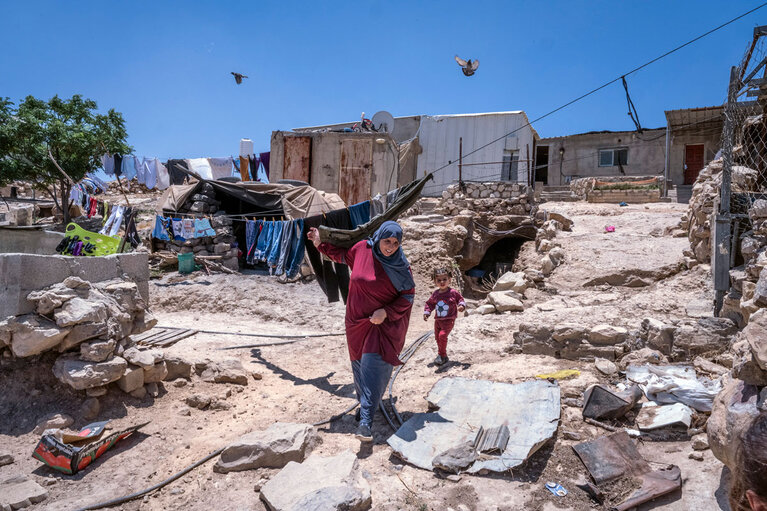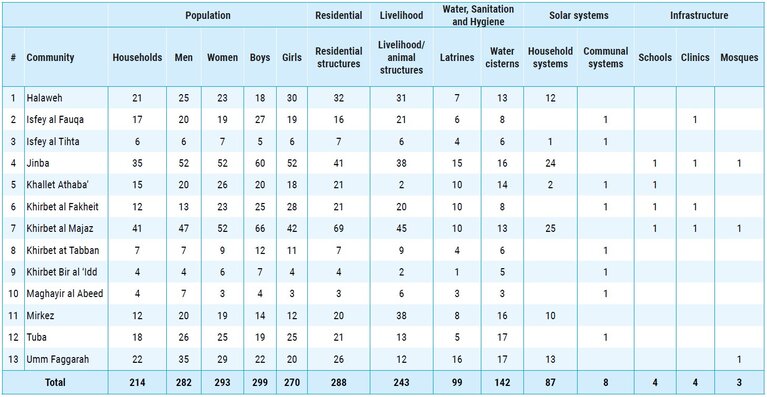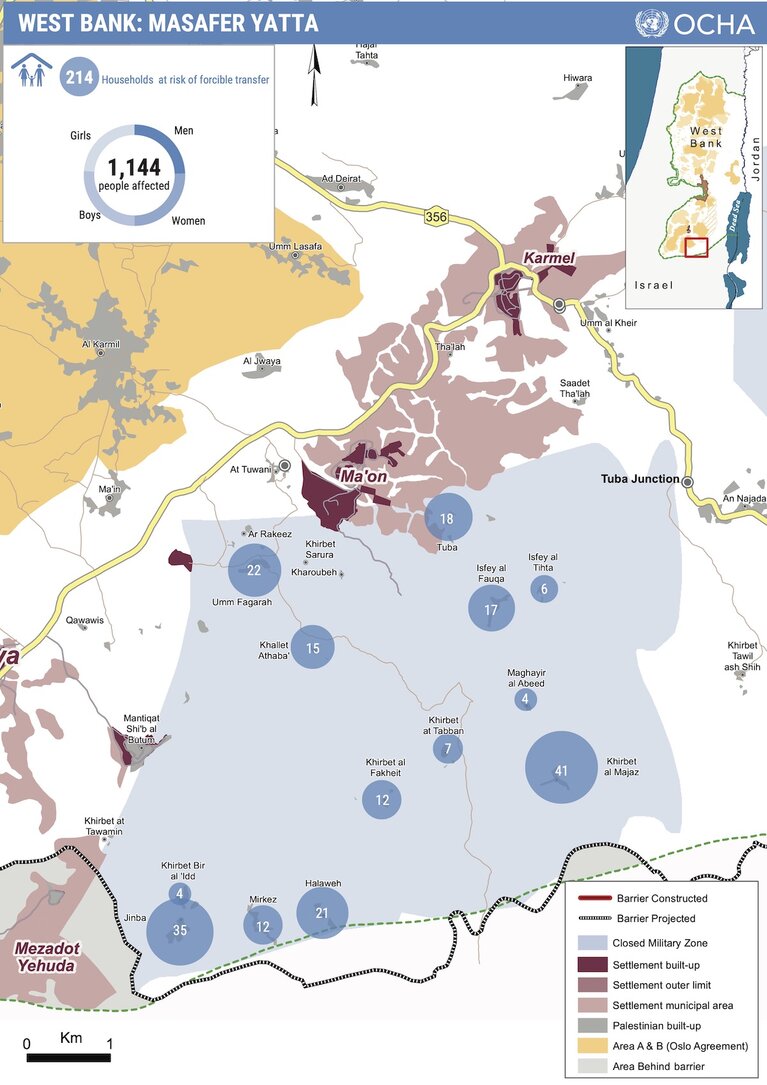Fact sheet: Masafer Yatta communities at risk of forcible transfer | June 2022
Key facts
- In the 1980s, Israeli authorities designated a part of Masafer Yatta in the South Hebron Hills as ’Firing Zone 918’, a closed military zone. Since this declaration, residents have been at risk of forced eviction, demolition, and forcible transfer. The two villages of Khirbet Sarura and Kharoubeh no longer exist after their homes were demolished.
- Approximately 20% of the West Bank has been designated as “Firing Zones”, affecting over 5,000 Palestinians from 38 communities.
- Currently in Masafer Yatta, 215 Palestinian households live in the area, including about 1,150 people, of which 569 are children.
- In 1999, the Israeli government issued eviction orders against approximately 700 Palestinian residents of Masafer Yatta for “illegally living in a firing zone”, as a result of which the Israeli military evicted by force most of them and destroyed or confiscated their homes and property. This eviction contradicted an existing Israeli military order, which stipulated that the restrictions regarding the firing zone would not be applied to existing residents of the area.[1]
- A few months later, the Israeli High Court of Justice (HCJ), in response to a petition filed on behalf of the residents, issued an interim injunction allowing most of the people to return, pending a final court decision. However, the existence of eviction orders left residents living under the constant threat of destruction of their properties and the risk of forcible transfer.
- In a 2012 petition to the HCJ, the Israeli military reasserted its right to evict eight of the thirteen communities from the area, while offering them access to the land for cultivation and grazing only on weekends and Jewish holidays. Legal action, humanitarian aid and advocacy challenged this decision and provided temporary protection from forced eviction to the Palestinian residents of Masafer Yatta.
- During an August 2020 court hearing, Israeli authorities argued that the Palestinian communities had not been permanent residents of the area when it was declared a firing zone, and therefore did not have the right to continue living in their homes.
- In July 2020, a transcript was submitted to the court of a 1981 hearing in which the then Minister of Agriculture instructed Israeli Forces to create training zones in the area to displace the Palestinian residents.[2]
- In parallel, communities in Masafer Yatta have been subject to several waves of demolitions and demolition orders since 1999, including against villages outside the firing zone.[3]
- On 4 May 2022, the HCJ ruled that there were no legal barriers to the planned expulsion of Palestinian residents from Masafer Yatta to make way for military training,[4] effectively placing them at imminent risk of forced evictions, arbitrary displacement, and forcible transfer.
- Since the 4 May 2022 court ruling, Israeli authorities have increasingly intensified a coercive environment for Palestinians in Masafer Yatta:
- 18 May: Israeli forces issued a military seizure order for the construction of a two-lane patrol road in the ‘Firing Zone’.
- 11 May and 1 June 2022: Dozens of Palestinians had their homes demolished in Khirbet Al Fakhiet and Mirkez. For some of them, the 1 June demolition was the third time to lose their homes in less than a year.
- 7 June: Israeli authorities issued demolition orders for all seven homes and most livelihood structures in Khirbet at Tabban.
- 10 June: Israeli forces went house to house in most communities to photograph residents’ faces and identification documents, raising fear among residents of increased restrictions on movement.
- 16 June: a day after it was announced that a military training exercise would take place in the area, additional demolition orders were issued for 20 structures in Khallet Athaba’.
- 20 June: A declaration delivered by Israeli Forces to the lawyers in Masafer Yatta indicated that the military training would take place for a period of 4 weeks.
- 21 June: A military training exercise began with the military placing targets close to inhabited residential areas within Masafer Yatta. Since military training began, there has been an increase in movement restrictions imposed on the community by Israeli Forces, even on days when training is not taking place
- The residents of Masafer Yatta are among the most vulnerable in the occupied Palestinian territory (OPT) and are dependent on humanitarian aid, due to a restrictive and discriminatory planning regime. The Israeli authorities have issued demolition or ‘stop work’ orders against most of the homes, animal shelters, cisterns, and community infrastructure on the grounds that they were built without building permits, which are almost impossible to obtain, impeding the development of adequate housing, infrastructure, and livelihoods.
- Communities in the entire area live in a constant state of fear. In addition to the threat of their homes being demolished, communities also face violence from settlers residing in a nearby outpost, who have blocked roads in the area, attacked herders, and set haystacks and grazing areas on fire, undermining their physical security, negatively affecting mental and psycho-social health, lowering their standard of living, and increasing the dependence on humanitarian aid. Herding activities are the main source of income for the community, but access to grazing lands has been reduced due to military and settlement activity. This has increased the dependence on fodder, the price of which has increased exponentially during the war in Ukraine.
- Humanitarian organizations and donors have been providing assistance to the communities in Masafer Yatta to meet their basic needs, including water and electricity, and prevent their forcible transfer. However, the Israeli authorities are impeding such efforts by the issuance of demolition or ‘stop work’ orders, by confiscation of vehicles and equipment, and by restrictions on physical access to land and of humanitarian workers to the area. The four schools in the area, all of which were established with support from international donors, have pending demolition orders, as do the four clinics which are serviced by mobile health teams. Evictions would result in a multitude of humanitarian needs that would have to be addressed to ensure people’s protection and access to essential services.
- The forcible transfer of civilians from, or within, the OPT is absolutely prohibited under international humanitarian Law. Israeli authorities should halt all coercive measures including planned evictions, demolitions, and military training in residential areas.
Table 1: Number of people and structures at risk of forcible transfer and demolition in Masafer Yatta
Source: Office for the Coordination of Humanitarian Affairs (OCHA) OPT
International law and the case of Masafer Yatta
- Forced Evictions resulting from demolitions are a gross violation of human rights including the right to adequate housing, water, sanitation, health, education, and privacy.[5]
- If followed through, forced evictions resulting in displacement could amount to forcible transfer, which is a grave breach of the Fourth Geneva Convention and thus a war crime.[6] Any evictions carried out in this context would moreover raise concern of arbitrary displacement prohibited by the Guiding Principles on Internal Displacement.[7]
- Regarding forcible transfer, the term ‘forcible’ “is not restricted to physical force, but may include threat of force or coercion, such as that caused by fear of violence, duress, detention, psychological oppression or abuse of power, against such person or persons or another person, or by taking advantage of a coercive environment.” This has also been incorporated in the International Criminal Court (ICC) Elements of Crimes relating to the definition of displacement and forcible transfer.
- Article 49 of the Fourth Geneva Convention allows for the temporary evacuation of protected persons for their own security or for an imperative military reason. However, Israeli firing zones serve the primary purpose of military training and, in the absence of active hostilities in the occupied West Bank, this does not meet the threshold of imperative military reasons or absolute necessity for military operations that may justify any evacuation of the population or seizure or destruction of private property.[8] In any event, any permissible evacuations can only be temporary: According to article 49 the Persons evacuated “shall be transferred back to their homes as soon as hostilities in the area in question have ceased.”
- Forcible transfer is also similarly prohibited by customary international law. According to Rule 129 of the International Committee of the Red Cross (ICRC) Customary International Humanitarian Law (IHL) Study: “Parties to an international armed conflict may not deport or forcibly transfer the civilian population of an occupied territory, in whole or in part, unless the security of the civilians involved or imperative military reasons so demand.”
- The continued evictions of Palestinians and settlement expansion during fifty-five years of occupation alters the reality on the ground, contrary to international humanitarian law and the legally binding resolutions of the United Nations Security Council. The High Court’s 4 May ruling on Masafer Yatta appears to be part of a wider policy of Israel in the territory it occupies to use closed military areas, leading to confiscation and demolitions of Palestinian lands and homes, in some cases to allow for the establishment and expansion of settlements. Documented cases of transfers of land from firing zones to settlements exacerbate these concerns.[9]
- Israeli regulations, policies and practices affecting Palestinians in Israeli declared firing zones or their vicinity exacerbate the coercive environment[10] that places these communities under an extreme pressure to move, raising an imminent risk of forcible transfer.
- Closed military zones further limit Palestinian privately owned pastureland and impose severe restrictions on Palestinian movement and livelihood, raising concerns of violations of human rights.[11]
[1] A/HRC/24/30, para.28.
[2] Document exposed by Akevot: Ariel Sharon instructed IDF to create training zone to displace Palestinians | Akevot and Haaretz, 9 August 2020.
[3] Report of the Secretary General on Israeli settlements in the Occupied Palestinian Territory, including East Jerusalem, and the occupied Syrian Golan (A/76/336), 23 September 2021, para 50-5.
[4] https://www.ochaopt.org/content/statement-united-nations-resident-and-humanitarian-coordinator-occupied-palestinian-territo-ry-lynn-hastings.
[5] Language from the UN Secretary General report on settlements, A/72/564, Para 49. See International Covenant on Economic, Social and Cultural Rights, Articles 11, 12 and 13 and General comment No. 7: The right to adequate housing (art. 11 (1) of the Covenant): Forced evictions.
[6] Language from the latest UN Secretary General report on settlements, see A/76/336, para 39 and para 57. See Fourth Geneva Convention, arts. 49 (1) and 147; and Rome Statute of the International Criminal Court, art. 8 (2) (b) (viii).
[7] Guiding principle 6b. The Guidelines further state that “States are under a particular obligation to protect against the displace-ment of indigenous peoples, minorities, peasants, pastoralists, and other groups with a special dependency on and attachment to their lands (guiding principle 9).
[8] Language from the latest UN Secretary General report on settlements, see A/76/336, para 55.
[9] A/73/410, para.28.
[10] A/HRC/24/30, paras.28 and 29.
[11] International Covenant on Civil and Political Rights, art. 12; International Covenant on Economic, Social and Cultural Rights, art.11.












